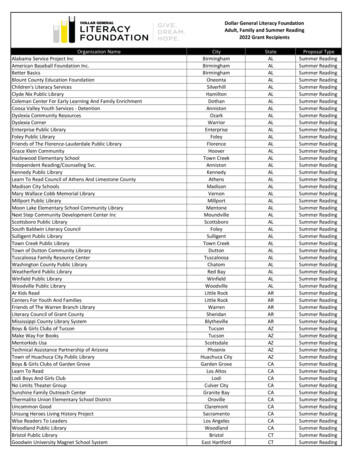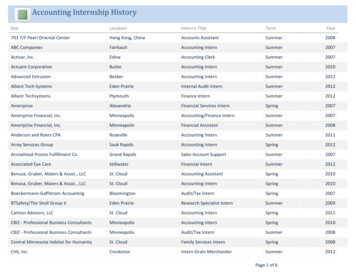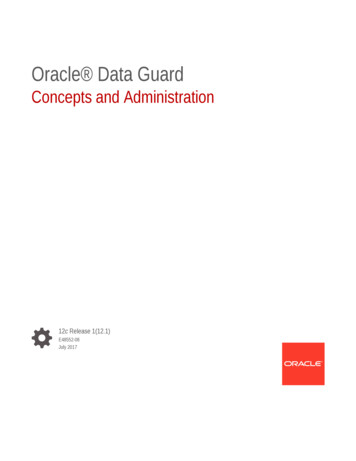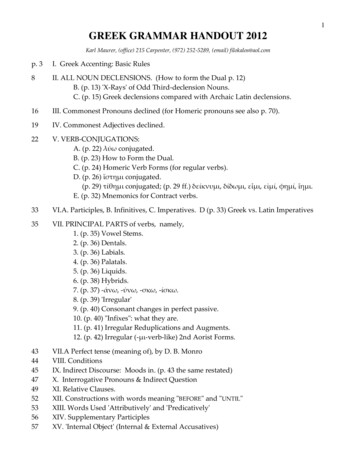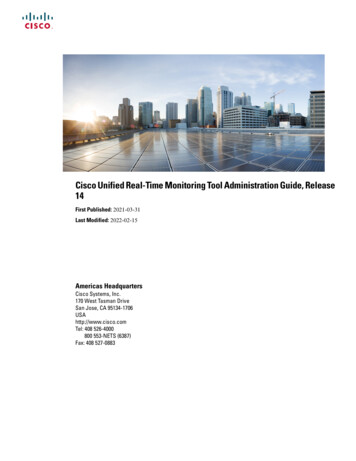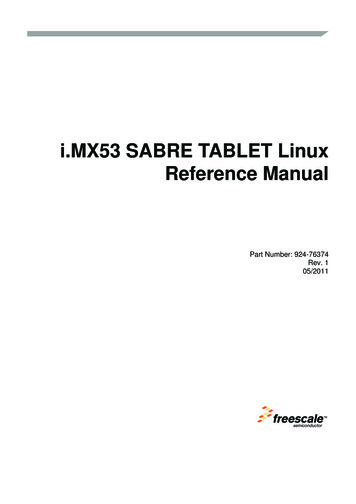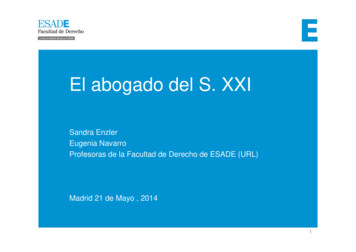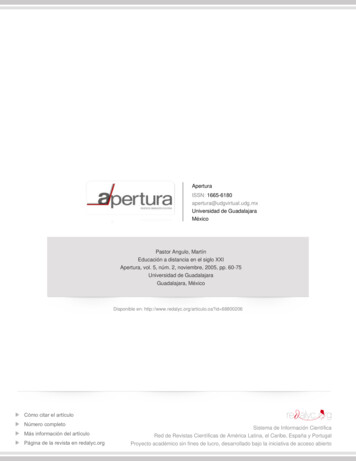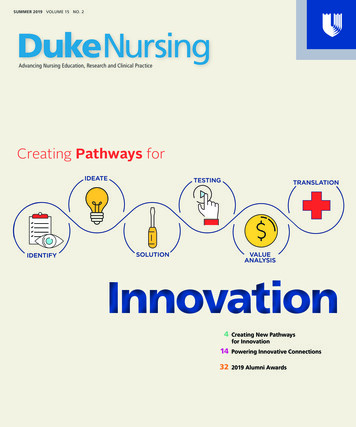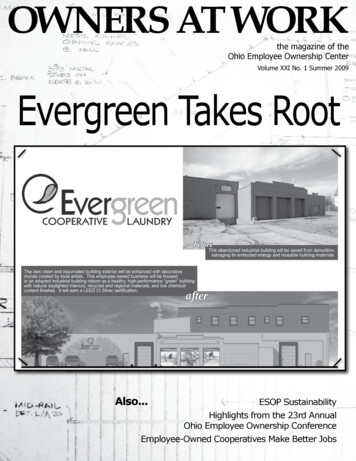
Transcription
OWNERS AT WORKthe magazine of theOhio Employee Ownership CenterVolume XXI No. 1 Summer 2009Evergreen Takes RootAlso.ESOP SustainabilityHighlights from the 23rd AnnualOhio Employee Ownership nersEmployee-Owned Cooperatives Make Better Jobs11
Table of ContentsOWNERS AT WORKEditorJacquelyn Yates jyates@kent.eduStaff WritersJim Anderson jander77@kent.eduSteve Clem cclem@kent.eduChris Cooper ccooper1@kent.eduJohn Logue jlogue@kent.eduBill McIntyre bmcinty2@kent.eduRoy Messing rmessin2@kent.eduJay Simecek jsimecek@kent.eduKaren Thomas kthomas@kent.eduLayout & DesignChris Cooper & Jacquelyn YatesStaff of the OEOC are not licensed attorneys, taxprofessionals, valuators, or any other professionrequiring licensing, and therefore, nothing in thisnewsletter should be construed to be legal, tax,valuation, accounting or financial advice. Pleasesee your professional advisor for guidance on thespecifics of your situation.To receive a free subscription, makean address change, and for other inquiries send relevant information to:Owners At WorkOhio Employee Ownership Center113 McGilvrey HallKent State UniversityKent OH rs At Work (ISSN 1046-5049) is publishedtwice a year by the OEOC. Copyright Ohio Employee Ownership Center of Kent State University. Letters, articles, requests for permission toreprint and subscriptions (which are free) shouldbe sent to the editor. Owners At Work is fundedin part by the Ohio Department of Development Labor-Management Cooperation Program.The OHIO EMPLOYEE OWNERSHIP CENTER(OEOC) is a university-based program which provides information and technical assistance to retiring owners, buyout committees, labor unions,managers and community-development organizations interested in exploring employee ownership.Center staff can help locate competent and appropriate legal and financial advisors, and performinitial assessments to determine whether employeeownership is a viable option. The OEOC developsresource materials on employee ownership and participation systems, sponsors workshops and conferences for the general public, develops and deliverstraining programs for employee owners, facilitatescooperation among employee-owned firms, coordinates a comprehensive succession planningprogram, and assists international efforts to privatize businesses through employee ownership.The OEOC is funded by grants from the OhioDepartment of Development’s Office of Labor/Management Cooperation, the Ohio Department of Job and Family Services, as wellas contributions from Kent State University,Friends of the Center, and the companies thatcomprise Ohio’s Employee-Owned Network.Employee Ownership News32008-2009 Friends of Center Honor Roll5Green Cleaning Co-ops Offer Better Work and Pay6Minimize Surprises in ESOP Repurchase Obligation7“Are ESOPs Sustainable?” - Keynote Address - Pater Paquette1023rd Annual Conference Recap12Revitalizing Communities Through Employee Ownership - Keynote Address - Bob Eckardt14Evergreen Cooperative Laundry Begins Construction16OAW Co-Sponsors18-23Upcoming Network Events24Publisher’s NoteAre ESOPs sustainable in the long run? And, if so, how? This issue of Owners at Workhas a special focus on these questions.Peter Paquette, Vice President and Treasurer of Massachusetts’ Claremont FlockCorporation, has been a key figure in raising this discussion nationally. He addressed thequestion at the 2009 Ohio Employee Ownership Conference, and we have printed a shortenedversion of his comments as “Are ESOPs Sustainable?” A sidebar to the Paquette articlespeaks to what the directors of Ohio employee-owned companies can take into considerationin making their decisions. Note that Ohio corporate law, unlike Delaware’s, gives directorslatitude to consider interests of the employees. other stakeholders and the community, as wellas those of the shareholders.One of the major threats to ESOP sustainability is the failure to plan for repurchaseobligation. Bill McIntyre’s “minimize surprises” philosophy has much to recommend itfor managing the impact of repurchase liability. This article should be a “must” for ESOPcompany boards and other fiduciaries, especially following the Antioch Company bankruptcyreported in the last issue of OaW (“Antioch Enters and Exits Bankruptcy”).Can we start new employee-owned businesses and take them to scale? That’s a secondfocus of this issue: the new Evergreen Cooperatives in Cleveland. These employee-ownedcooperatives will provide employment and build assets for their working members in theGreater University Circle neighborhoods, in part based on contracts with the major nonprofit institutions in this area, which include the Cleveland Clinic, University Hospitals,and Case Western Reserve University. As the name denotes, they are committed to usinggreen technologies and reducing the carbon footprint by providing goods and services to these“anchor” non-profits.“Revitalizing Communities through Employee Ownership” by the Cleveland Foundation’sBob Eckardt explains the Evergreen project; the Cleveland Foundation’s commitment hasbeen key to getting the Evergreen co-ops off the ground. Jackie Yates provides a case studyof the Evergreen Cooperative Laundry, the first of the Evergreen Cooperatives, chosen aftercareful market research indicated strong demand in a growing market. Many of the ideasbehind the Evergreen Cooperatives are drawn from the Mondragon cooperatives in Spain,highlighted most recently in the last issue of OaW (“Cleveland Goes to Mondragon” and“Spanish Lessons: Employee-Owned Companies in Ohio on a Mass Scale?”)This issue also features an article on the green house-cleaning cooperatives set up byWAGES in San Francisco. After years in the trenches working to set up individual co-ops,WAGES has developed a network of cleaning cooperatives that are raising wages and benefitsfor immigrant women in the Bay Area. It’s a model that deserves our attention.2Owners At Work Summer 2009
The Evergreen Cooperative Laundry Begins ConstructionJust the First Step .AJacquelyn Yateslthough the Evergreen Cooperative Laundry,the ground, in communities. There are certain conditionswhich poured concrete on May 28, 2009, will bethat need to exist that allow for that strong, healthya small enterprise within the multibillion dollardemocratic life to flourish. One of which is a sufficientinitiative to redevelop Cleveland’s Greater Universityamount of economic stability in the community. Not thatCircle area, its many creators have launched it with thethere shouldn’t be growth and expansion, but stability soexpectation that it will play a very large role in establishingthat people are not scrambling for their next job and can’ta new generation of worker cooperatives in Cleveland.afford food for their family.”The laundry is part of the Cleveland Foundation’sIf building democracy through building economiceconomic inclusion strategy to reach out to the Greaterstability was to be the philosophy of the GUC project, howUniversity Circle (GUC) neighborhood residents with ancould it be implemented? “You must build assets. Youapproach that promises more visible success than pastmust develop long term leadership, and you need assetsefforts. “For years, I ran job training programs worthto do that. Without that, you have the boom and bust ofhundreds of millions of dollars, and yet when I lookedcommunity development: because the people who youaround the neighborhoods, I thought, ‘Where is thehelp succeed leave, then drugs and crime grow back andimpact?’” said India Pierce Lee, Program Director forthe community crashes again. This is the cycle that facesNeighborhoods, Housing, and Community Developmentso many community development corporations over andat the Cleveland Foundation.over. The trick to avoiding this cycle is to anchor both peopleLee’s thousand-watt smile is on full power when sheand institutions by building assets in the community,”talks about the plan for the cooperatives. “This is a way tostated Cicero Wilson, CEO of Mid-Bronx Desperadosget the residents long-term employment and ownership,”Corporation at the December 2006 roundtable.she says.The idea of cooperatives and employee ownership wasfirst raised in a communitywealth-building roundtablein December 2006, undation,theGundFoundation and the Sistersof Charity. They invited theDemocracy Collaborative atthe University of Maryland,a nonprofit group with aphilosophiccommitmentto economic stability as thefoundation of democracy,to organize the event. SaidTed Howard, ExecutiveDirector of the DemocracyCollaborative, “Our viewis that where democraticlife gets created is really incommunities where peoplereside. Not that nationalpolicy isn’t important, butthat if you want a “bigD” democracy in whichnational life is really healthyandmeaningfulandvibrant, in which peopleexpress themselves as strong Evergreen gets under way: from left to right, Dick, Operations Manager, Evergreen Cooperative Laundry;democratic citizens, where Jake, a prospective employee; Jill, Executive Director, Towards Employment; Willie, a prospective employee;that really gets built is on and Jim, Program Coordinator at the Ohio Employee Ownership Center.16Owners At Work Summer 2009
Evergreen Cooperative Laundry (ECL)A few participants at the roundtable were the ones whoidentified the market possibilities for a laundry. It will beup to the laundry to compete for business and deliver aquality product. A feasibility study revealed that althoughcommercial laundries are known to pay low wages, they arein fact profitable businesses whose earnings go to ownersand shareholders, not the employees. Making the employeesowners through a cooperative meant that an employeeowned laundry could immediately offer jobs paying a littlebetter than the going rate for such work, offer better benefitsand also be a wealth-builder for employees over the years.To get the laundry up and running, the Ohio EmployeeOwnership Center provided from its staff Jim Anderson,a former CEO experienced with employee ownershipand large-scale industrial processes. Visiting someoperating laundries and prospecting for customers in theregion, Anderson, with business consultant Stephen Kiel,identified a potential customer base in the 10-county areaaround GUC. They found 53 hospitals and 259 nursinghomes washing an estimated 246 million pounds of laundryper year. Although many institutions do their laundry“in house,” Anderson found that ECL could do it morecheaply, with a greener process. The institutions could usetheir current laundry space for profitable activities andretrain and redeploy their current laundry employees intobetter jobs in their growing businesses. It was a solutionwhere everyone would benefit.“We can probably break even at 2 percent of the market,make money at 3 or 4 percent, and we’re still a very smallshare of a growing market,” observed Anderson. Kiel,who wrote the business plan for the laundry, observed,“The most important thing is that we’re not looking topenetrate [the market] a great deal in order to reach ourhurdle. We’ve got the footprint and the capacity to do 15million pounds per year, but at 10 million pounds we’relooking to penetrate 4% of the marketplace. We think thatis a practical challenge and something that is achievable.”As a legal entity, a cooperative is a private companyequally owned and democratically controlled by itsmembers, in this case its employees. The laundry will startoperations with 25 employees. If business is good, it willadd 15 more employees on a second shift. Cooperativesusually begin with a few workers pooling their workand their small personal funds to build up the enterprise.However, the laundry must have expensive machinery fromthe outset. It will receive a substantial capital investmentfrom foundations and public investment to purchase itsequipment and help from state and local government totrain its employees. Management, provided by the OEOC,will hire employees from the neighborhoods who will thenbecome co-op members after meeting the probationaryperiod and applying to join. They will pay a one-timemembership fee through a wage check off.Anderson and Kiel planned for six months to launchthe laundry -- two months to finalize and order equipment,two months to install the equipment, and two months oftraining for the employees. The equipment was ordered onJuly 2, 2008. But funding proved more difficult to obtainthan anticipated, delaying the opening from late winterOwners At Work Summer 20092008 to late summer 2009.Modern commercial laundries are capital intensive,and lenders are always dubious of start-ups. In addition,the timing was bad: ECL’s search for financing kicked intohigh gear about the time the 2008 banking crisis shut downlending. Putting the financing together took six monthslonger than expected and required Cleveland Foundationguarantees to First Merit, the local commercial lender whichultimately put in half the loan. Shorebank, which steppedin for the other half, got first position on the machinery andequipment, enhanced by the fact that it owns the real estate.Most of the financing came from the City of Cleveland,the Cleveland Foundation, and publicly subsidized NewMarket Tax Credits through US Bank (See table below).The financing could never have come together without thecommitment and support of the Cleveland Foundation.Financing Evergreen Cooperative LaundrySenior debt:First Merit (local commercial bank)ShorebankCity of Cleveland“Equity” (sub-debt through Evergreen CoopDevelopment Fund)New Market Tax CreditsCleveland FoundationWorking capital:City of ClevelandCommon Wealth Revolving Loan 0,000250,0005,700,000The laundry washing and drying equipment is madein the U.S., and it is the very latest and most efficient. Toreduce the energy needs of the laundry, heat from theused water will be recycled to heat clean water and thelaundry will use the “greenest” chemicals acceptable to itscustomers. Skylights will let in natural daylight, and thereare plans to add rooftop solar panels to further conservegas and electricity.The laundry building is located in the Shore BankComplex on 105th and Elk in the Glenville neighborhood,near the boundary of the GUC project. The facility is on abus line and there is nearby daycare for workers.An experienced manager is already on staff as well asa maintenance engineer and a leader for operations. Thesethree key employees will receive specialized training andtogether they will train the other employees.The final two months of startup will be devoted to trainingthe rest of the employees. With a workforce drawn frompeople who may have been out of work for a long while,there will be substantial training for all jobs. Anderson said,“There were four training issues that we knew we needed toaddress: (1) basic job skills; (2) environmental sustainabilitypractice/procedures; (3) equipment operations and (4)employee-ownership training.continued next page 17
“And there’s a fifth kind of training that goes to helpingfamilies to function when their main problem-solver andmain wage-earner is at work. We’re going to have, on site,someone who can say, ‘You have responsibility to yourfamily and to your job. Let’s figure out how to get somebodyin your home to deal with those [family problem] issues inthe future.’“The training is definitely connected to our wholebusiness picture: We’re going to have higher quality andlower costs, because we’re going to have significantlyreduced turnover. Being an employee owner, with yourown vested account generating income and funds for youin the future, is going to provide some glue to keep youhere in the company.”Despite its annual goal of 5 million pounds of laundryper year at startup, expanding to perhaps 15 millionpounds over 10 years, Evergreen Cooperative Laundryisn’t expected to take anyone’s job. Health care laundryis a growing business area, with nursing homes andhospitals flourishing and expanding to serve the growingnumber of retirees.to be just the first new employee owned enterprise inthe GUC. Additional business opportunities on thehorizon include a solar panel installation and servicecompany and an industrial scale greenhouse. Afterrepaying its startup debts, each successful cooperativewill contribute a small portion of its profits to theEvergreen Cooperative Development Fund. It willbe a nonprofit fund used to start new cooperativebusinesses in GUC. Says Howard, “It will be a kind ofventure capital fund targeted specifically at cooperativedevelopment.”Having a variety of cooperative enterprises goingat one time will spread the risks of failure and increasethe probability that some will succeed. And if just somesucceed, they can grow and expand to employ moreneighborhood residents.How long will all this take? Howard observes thatit took a long time for economic decline in Cleveland toget to where it is today. “In the 1950s there were over800,000 people who lived here and now there’s less than450,000.”Growing Employee Ownership: The EvergreenCooperative Development FundHowever, the horizons for Evergreen reach beyondcreating one successful business. The laundry is expectedJacquelyn Yates is Research Director at the OEOC and Editorof Owners at Work. She is associate professor of political science at Kent State University.OAWThanks to Our SponsorsTHIS IS AN ADVERTISEMENTComing in theNext Issue.Karl Warnke, CEO, Davey Tree,on Davey’s 30 years of employeeownershipYour Guide to the World of ESOPsYour business.Our Compensation and Benefits Practice Group canhelp you navigate the complex corporate, taxation,securities and labor law issues relating to ESOPs. Wealso assist plan fiduciaries with fulfilling their dutiesunder ERISA.We will work with your other advisors to structure anESOP that works for the seller, the company and theemployees.It’s personal.Bill McIntyre, OEOC, on how ESOPcompanies can deal with unsolicited offerswww.dinslaw.comFor more information about Dinsmore & Shohl’sESOP services, contact Ben Wells at 513.977.8108255 E. Fifth StreetOHIO18KENTUCKYSuite 1900Cincinnati, OHPENNSYLVANIA45202WEST VIRGINIAOwners At Work Summer 2009
ESOP Sustainability Highlights from the 23rd Annual Ohio Employee Ownership Conference Employee-Owned Cooperatives Make Better Jobs Evergreen Takes Root OWNERS AT WORK . One of the major threats to ESOP sustainability is the failure to plan for repurchase obligation. Bill McIntyre's "minimize surprises" philosophy has much to recommend it


